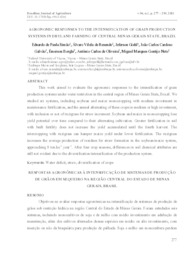Agronomic responses to the intensification of grain production systems in dryland farming of central Minas Gerais State, Brazil.
Agronomic responses to the intensification of grain production systems in dryland farming of central Minas Gerais State, Brazil.
Author(s): SIMÃO, E. de P.; RESENDE, A. V. de; GIEHL, J.; GALVÃO, J. C. C.; BORGHI, E.; OLIVEIRA, A. C. de; GONTIJO NETO, M. M.
Summary: This work aimed to evaluate the agronomic responses to the intensification of grain production systems under water restriction in the central region of Minas Gerais State, Brazil. We studied six systems, including soybean and maize monocropping with medium investment in maintenance fertilization, and the annual alternating of these crops in medium or high investment, with inclusion or not of ruzigrass for straw increment. Soybean and maize in monocropping lose yield potential over time compared to their alternating cultivation. Greater fertilization in soil with built fertility does not increase the yield accumulated until the fourth harvest. The intercropping with ruzigrass can hamper maize yield under lower fertilization. The ruzigrass increases the average production of residues for straw formation in the soybean/maize system, approaching 8 ton.ha-1 .year-1. After four crop seasons, differences in soil chemical attributes are still not evident due to the diversification/intensification of the production system.
Publication year: 2021
Types of publication: Journal article
Unit: Embrapa Maize & Sorghum
Keywords: Deficiência Hídrica, Diversificação de Cultura, Palhada
Observation
Some of Embrapa's publications are published as ePub files. To read them, use or download one of the following free software options to your computer or mobile device. Android: Google Play Books; IOS: iBooks; Windows and Linux: Calibre.
Access other publications
Access the Agricultural Research Database (BDPA) to consult Embrapa's full library collection and records.
Visit Embrapa Bookstore to purchase books and other publications sold by Embrapa.

